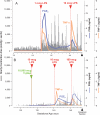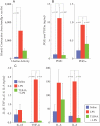Pretreatment with toll-like receptor 4 antagonist inhibits lipopolysaccharide-induced preterm uterine contractility, cytokines, and prostaglandins in rhesus monkeys
- PMID: 18187405
- PMCID: PMC2774271
- DOI: 10.1177/1933719107310992
Pretreatment with toll-like receptor 4 antagonist inhibits lipopolysaccharide-induced preterm uterine contractility, cytokines, and prostaglandins in rhesus monkeys
Abstract
Intrauterine infection, which occurs in most early preterm births, triggers an immune response culminating in preterm labor. The authors hypothesize that blockade of lipopolysaccharide (LPS)-induced immune responses by a toll-like receptor 4 antagonist (TLR4A) would prevent elevations in amniotic fluid (AF) cytokines, prostaglandins, and uterine contractility. Chronically catheterized rhesus monkeys at 128 to 147 days' gestation received intra-amniotic infusions of either (1) saline (n = 6), (2) LPS (0.15-10 microg; n = 4), or (3) TLR4A pretreatment with LPS (10 microg) 1 hour later (n = 4). AF cytokines, prostaglandins, and uterine contractility were compared using 1-way ANOVA with Bonferroni-adjusted pairwise comparisons. Compared with saline controls, LPS induced significant elevations in AF interleukin-8 (IL-8), tumor necrosis factor (TNF)- alpha, PGE(2), PGF(2)(alpha), and uterine contractility (P < .05). In contrast, TLR4A pretreatment inhibited LPS-induced uterine activity and was associated with significantly lower AF IL-8, TNF-alpha, PGE(2), and PGF(2)( alpha) versus LPS alone (P < .05). Toll-like receptor antagonists, together with antibiotics, may delay or prevent infection-associated preterm birth.
Figures


References
-
- Chellam VG, Rushton DI. Chorioamnionitis and funiculitis in the placentas of 200 births weighing less than 2.5 kg. Br J Obstet Gynaecol. 1985;92:808–814. - PubMed
-
- Hillier SL, Martius J, Krohn M, Kiviat N, Holmes KK, Eschenbach DA. A case-control study of chorioamnionic infection and histologic chorioamnionitis in prematurity. N Engl J Med. 1988;319:972–8. - PubMed
-
- Romero R, Manogue KR, Mitchell MD, et al. Infection and labor. IV. Cachectin-tumor necrosis factor in the amniotic fluid of women with intraamniotic infection and preterm labor. Am J Obstet Gynecol. 1989;161:336–41. - PubMed
-
- El-Bastawissi AY, Williams MA, Riley DE, Hitti J, Krieger JN. Amniotic fluid interleukin-6 and preterm delivery: a review. Obstet Gynecol. 2000;95:1056–64. - PubMed
-
- Romero R, Ceska M, Avila C, Mazor M, Behnke E, Lindley I. Neutrophil attractant/activating peptide-1/interleukin-8 in term and preterm parturition. Am J Obstet Gynecol. 1991;165:813–20. - PubMed
Publication types
MeSH terms
Substances
Grants and funding
LinkOut - more resources
Full Text Sources
Other Literature Sources
Medical

